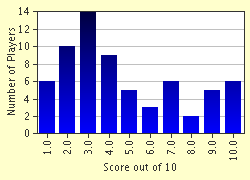Quiz Answer Key and Fun Facts
1. I am Greek scholar from Alexandria, and am known as the first woman to influence the study of mathematics. I wrote treatises on both math and astronomy, but none of my work is known to still exist. Who am I?
2. I am a French woman famous for my translation of Sir Isaac Newton's "Principia Mathematica". My knowledge of mathematics was such that students came to study with me - a rare occurrence in a time when women were not considered well educated, much less teachers. Who am I?
3. I was a child prodigy, giving math and philosophy lectures when I was young woman. I am most famous for my book, "Analytical Institutions", which includes discussions of algebra, geometry, and calculus. Who am I?
4. I was French, and came from a very conservative family that felt I should not be educated. I went on to produce a grand-prize-winning paper in 1816 on the calculus of variations and predicted the patterns formed by powder on a vibrating elastic surface. Who am I?
5. I was born in Russia in 1850, but I had to leave my homeland to fulfill my desire to study mathematics and science. Some of my most important work revolved around the theory of partial differential equations and the behavior of infinite sequences. I was also a gifted writer. Who am I?
6. I was an English research mathematician who, along with my husband, published the first book on set theory. I was also among the first women in Germany (where I traveled to study) to receive a doctorate on the same basis as male candidates. Who am I?
7. I was a German Jew who became one of the most important mathematicians of my time. I focused my studies in the field of abstract algebra, and emigrated to the United States when Hitler's anti-semitic policies forced me to leave. Who am I?
8. I was brought up in the "colored" school system of Washington DC in the 1930s. I went on to become one of the first three black women to recieve a PhD in mathematics in the United States. My career saw me working with NASA and IBM in their infancy, where I specialized in using numerical analysis and computer programming to track trajectories and space orbits. Who am I?
9. Though not generally recognized for my accomplishments in mathematics, I developed the polar area diagram and was an innovator in the collection and display of statistics. I was born in early 1800s, and spent much of life working to reform the British health care system. Who am I?
10. I was a retired United States Naval officer when I wrote the first compilier and later created the COBOL programming language. Who am I?
Source: Author
3thornes
This quiz was reviewed by FunTrivia editor
bloomsby before going online.
Any errors found in FunTrivia content are routinely corrected through our feedback system.

